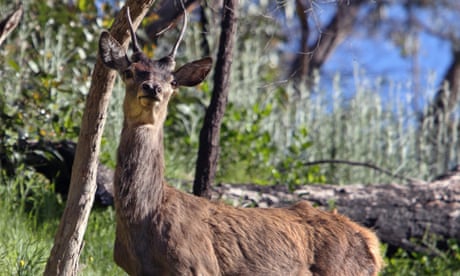- by foxnews
- 08 Apr 2025
Feral deer will become Australia’s ‘next rabbit plague’ without a containment zone, experts say
Feral deer will become Australia’s ‘next rabbit plague’ without a containment zone, experts say
- by theguardian
- 16 Dec 2022
- in news

Populations of feral deer have increased tenfold in the past two decades with numbers now too high to be managed by recreational hunting or other recent control measures.
Numbers of the invasive species are now so large in some parts of the east coast that a new national strategy by federal and state governments proposes establishing a "containment zone" to stop the spread of the animals westward across the country.
Environment groups and some land managers say the plan is necessary to suppress a species that is emerging as "the next rabbit plague" and to prevent "wall-to-wall deer across the continent".
''The deer plague has already taken over most natural areas on the east coast," the chief executive of the Invasive Species Council, Andrew Cox, said.
"Scientists now predict that without action feral deer will inhabit every habitat in every part of Australia."
Feral deer were introduced to Australia for hunting and farming. Over time, particularly with the decline of the venison industry in the 1990s, deer escaped, were released or were relocated for hunting.
Their numbers have exploded due to a failure by governments to control small populations. In 1980 there were an estimated 50,000 deer in Australia. In 2022, the number is estimated to be 1 to 2 million and the range inhabited by feral deer has almost doubled.
While they have not received the attention of other invasive species such as feral cats, their effect on vulnerable ecosystems is also destructive: they overgraze, trample vegetation, damage cultural sites, cause erosion and degrade water quality.
They also pose a biosecurity threat as potential carriers of disease and with large deer weighing in at more than 200 kilograms, are a major road safety risk.
"A few years ago when I talked to the panel beater in Jindabyne, he said he was now fixing more cars from running into deer than from kangaroos," said Ted Rowley, a beef cattle farmer.
Rowley was the chair of national working group for feral deer. He said in south-eastern New South Wales the deer problem reduced the stocking rate on farms, particularly in dry years. He said land managers were spending tens of thousands of dollars a year just managing deer populations.
"Many of the farmers and other land managers I work with see them as the next rabbit plague," he said.
Under the draft strategy, published Wednesday, large populations of deer along the eastern seaboard that are already too large to be eradicated would be controlled through measures such as aerial culling to keep their numbers at manageable levels.
A national "containment buffer zone" would be mapped to stop the establishment of new large populations in Queensland, New South Wales and Victoria and to stop populations in South Australia and Tasmania from spreading west. The goal is to eradicate deer that enter the buffer zone. Small feral deer populations beyond the containment zone would also be eradicated.
As a third measure, governments would develop - or reassess - specific plans to reduce deer in important environmental and cultural sites, such as Ramsar wetlands and heritage sites.
Rowley said for the national strategy to be successful, it would require cooperation from all land managers.
Cox said that included the state governments in Victoria and Tasmania, "where deer are still legally protected as a game animal for hunters, reflecting an outdated and early colonial attitude to this pest".
NSW, Queensland, Western Australia, South Australia, the Northern Territory and the ACT all recognise deer as a feral pest.
"Implementing this national plan is our best shot at avoiding wall-to-wall deer across the continent," Cox said.
The plan is open for public consultation until 20 March.
- by foxnews
- descember 09, 2016
Ancient settlement reveals remains of 1,800-year-old dog, baffling experts: 'Preserved quite well'
Archaeologists have recently unearthed the remarkably well-preserved remains of a dog from ancient Rome, shedding light on the widespread practice of ritual sacrifice in antiquity.
read more


